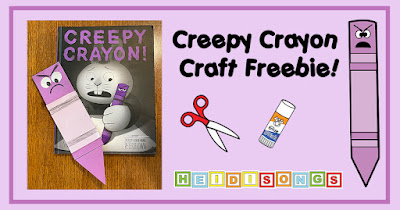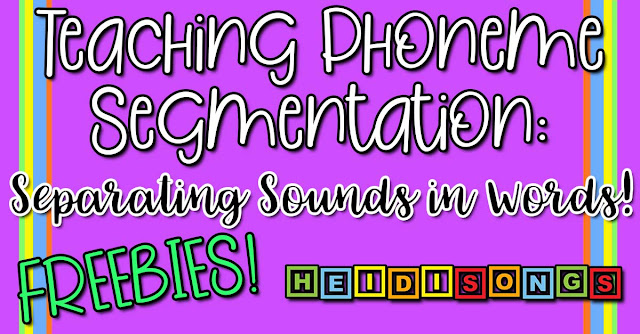Mouse Ears Addition & More!
Have you heard the news? We've Moved to HeidiSongs.tv!
Our new website features an online video streaming service, updated blog posts at Heidisongs.blog, and a wealth of fresh resources designed to make learning even more fun and engaging.
You can also continue shopping for our educational products there and at our Teachers Pay Teachers store!
Head over to HeidiSongs.tv now and explore all the exciting new features.
See you there!
__________________________________________________________________________
In this post, I'm excited to share my daily schedule with you, my "Mouse Ears Addition" Workmat, a Draw-a-Star Addition Worksheet, and a Color by Sight Word Native Alaskan Worksheet, too, which are all freebies! I hope you enjoy them!

Well, the weekend at the California Kindergarten Association Conference was a bit of a head rush, I must say! I met so many incredible and wonderful teachers with nothing but lovely things to say about my HeidiSongs resources and blog! Hearing about their successes with their students made everything seem so worthwhile. I also love to hear about how their children just LOVE the songs! I think that learning should be fun, as often as it possibly can be so and I’m so happy to have contributed to the happiness of some teachers and kids in our classrooms today! I was fortunate enough to speak to a much larger audience than was originally anticipated- nearly 200! They were a very responsive audience, and I surely enjoyed every minute! I hope that everyone that attended left with at least one or two useful ideas. I had the pleasure of watching Sheri Sutterley’s Mini-Keynote presentation, and she was wonderful!

A couple of nights ago, I posted on my HeidiSongs Facebook page this remark: “I feel like I'm trying to teach so much these days that I can't teach anything as well as I used to.” I would not have guessed at the amount of comments from people that immediately popped up! This is definitely a frustration for many of us. It just seems to be getting harder and harder to squeeze all of the requirements into the day, and I know that I often wind up skipping (or watering down) important lessons just to deal with classroom management issues each afternoon as the day progresses and the children become more and more tired. Teaching (and learning!) should be fun! But it’s pretty hard to relax and have fun with your students when you have to constantly watch the clock, as you struggle to squeeze just one more lesson into your day. Many of our colleagues have been forbidden to give their students recess more than twice a week, and some are not allowed to have it at all! If you have any tips for squeezing it all in while maintaining your sanity, post them on the HeidiSongs Facebook page! Let’s put our heads together and see what we come up with!
1. My Daily Schedule
Not long ago I was asked what my daily schedule looks like, so I sort of put it on my “to do” list to include it in my blog. I don’t know how useful this is to any of you, but here it goes! As you can see, I have music sprinkled in throughout the whole entire day, especially during transition times. When I need to introduce a song for the first time, then I do it at about 8:35 when I have the attention of the entire group. Then later, we can sing as much as we like during transition times, knowing that whomever is ready to join in and sing can review that song with us, but if they miss it because they are cleaning up, it is not a big deal.
7:45-8:00: Prep Time
8:00-8:15: Children arrive; outside recess.
8:25-8:35: Enter classroom, take roll, flag salute, update calendar. Read words and other flashcards stapled on wall next to calendar.
8:35-8:45: Music- Introduce or review any new songs that are necessary, based on the concepts on the Pacing Guide.
8:45-9:00: Explain what we will do at our centers during our rotation. Model the art project. Show what we will do at the other three centers as well. Sometimes I read a short book here. If writing is part of the rotation, then model the writing process at this time as well. If that happens, I usually wind up starting the rotation about five to seven minutes later. This shortens up all of the small group rotations, of course.
9:00-9:50: Small Group Rotation (part one)
We have four centers going at once. We do two rotations before recess, and two after.
1. Art: I have a volunteer run my art table.
2. Math: I have my aide run my math table.
3. Language Arts: I teach at this table.
4. “Extra” center: (either a math, science, social science, P.E., or language arts reinforcement activity is done at this table with another volunteer. If I am short a volunteer, then this center can be done independently. I always keep something in mind that the children can do alone, just in case a volunteer cannot come. One of the things that I keep on hand that the children can do independently is the Mini Sing-Along Song Books that are in our Sing and Spell Resource Workbooks. They have the words to the songs in them, and the children trace the target word on each page and then color or rainbow draw the words at the end. I do prefer to do this activity with the children, but I have found that they can easily complete and color these books alone if a volunteer doesn’t show up. They are supposed to read their books to a friend.
9:05-9:25: First rotation
9:25-9:30: Sing songs for transition (We do a lot of the Sing and Spell Sight Word Songs as a review here)
9:30-9:50: Second rotation
9:50-9:55: Sing songs for transition (We sing more Sing and Spell songs here, time permitting, or perhaps a few from Musical Math. If we are running late, then we don’t sing before we go out to recess.
9:50-10:15: Recess
10:20-10:40: Third rotation (We sing more Sing and Spell songs here, Sing songs for transition 10:40-10:45
10:45-11:05: Fourth rotation (We sing more Sing and Spell songs here, or some from Little Songs for Language Arts.
11:05-11:10: Get ready for lunch
11:10: Walk to the cafeteria
11:15-12:00: Lunch
12:00-12:05: Come back inside, settle down, etc.
12:05-12:20: Story time/Science/Social Science/Guided Drawing
12:20-12:30: Shared writing about what we learned during story time. Sometimes we sing again during this time, especially if we already did our shared writing time earlier that day. The Skip Counting songs from Musical Math are always a hit in the afternoon, because the Count By Two’s song is a little silly! The Counting to 100 Song is good exercise, too! :)
12:30-1:00: Inside Playtime (Children must make sure that their backpacks are all packed up before they may play so that they will be completely ready to go. Otherwise, it takes us a REALLY long time to do it later. But if I withhold playtime until they are packed up, then packing up goes incredibly FAST! If I can, I have a parent pass out their binders and papers, etc., during our rotation, so that there are only approximately six to eight children at a time at the cubbies.
1:00-1:05: Clean Up
1:05-1:20: Story/Songs/Talk about activities of the day/ Review concepts, etc.
1:20: Dismissal
1:30-2:15: After School Tutoring (Mondays, Tuesdays, and Wednesdays only)
• On Thursdays, we have our school wide Compact Day, so everyone gets out at 1:15, and then sometimes there are meetings or trainings to go to. Sometimes, the time is our own.
• On Fridays, we have time to plan as a Kindergarten team, so we don’t have to tutor. (Thank goodness!)
This is my basic weekly schedule in a nutshell! At the beginning of the third trimester, all of the Kindergarten students will start staying until 2:15 each day except Thursdays, and the after school tutoring groups will be dropped. Amazingly, parents often want to know why we don’t then keep those tutoring groups for an extra hour after that! As far as I am concerned, they are totally “fried” by then, and that would be a pointless waste of time! I’m so glad that our district administrators are not asking us to do this as of yet.
2. Getting Started with Addition
I usually introduce the concept of addition with my Addition Song from Musical Math, and by acting out addition stories. I also use my “Mouse Ears” addition workmat in small groups. I have no idea where the idea originated; I just know that I didn’t make it up! The workmat has one large circle in the middle and to smaller circles placed on the upper right and left so as to resemble ears.
Click here to download this page free. :)
For the activity, the children each get a basket of counters. One child is chosen to spin a spinner or roll a die. The whole group places that many counters in one of the mouse’s ears. Then, another child spins the spinner, and the whole group puts that many markers in their remaining individual mouse ears.
Then, the teacher writes the equation on a white board, but saving the answer for the end, of course! The teacher asks the children to take all of their counters and put them in the mouse’s face. The children combine both groups of counters into one group, and then everyone counts up the total. Then the teacher writes the answer on her the white board, and the group reads it back. I am including a master of the mouse ears here as a free download. There’s really nothing to it, though!
3. Learning to Add by Drawing STARS!
Here is a very basic addition worksheet that I came up with as my husband drove us up to CKA. In it, the children draw use the “connect the dots” format to learn how to draw a star. Then they wind up drawing stars to help them solve addition problems. My kids almost all already knew how to make a star because they learned how to do this in our Christmas Countdown book that is included on the Printable Projects Resource CD and Little Songs for Language Arts CD’s. But it was a good review, and I think they enjoyed it! If fact, I know that most of them really did, because now they are drawing stars on just about EVERYTHING!!! LOL!

4. Color By Sight Words?
Sometime during Christmas Vacation I had decided that I wanted to try to create a simple worksheet that had the children coloring by the sight words. So during that time, I created this
5. Check this link: My new friend, Allie Magnuson has created this blog on Scholastic.com. She has done some really neat things with slide shows and has some cute videos of her kids! This week’s entry has a lot of ideas for teaching the alphabet, so if you are working on that, boy, do I have a link for you! If you are also blogging about your class’s activities, I would love to see a link! Let me know in the comments section!
----------------------------------
Follow me! Did you enjoy this post? Do me a favor and share it with your friends! And follow this blog by signing up for my email updates here, or follow on Bloglovin', or follow me on TPT! I'm also on Pinterest, Facebook, Twitter, Instagram, Google+ and YouTube, too! Don't forget to sign up for our email newsletter for special deals and promo codes that you won't find out about anywhere else.















